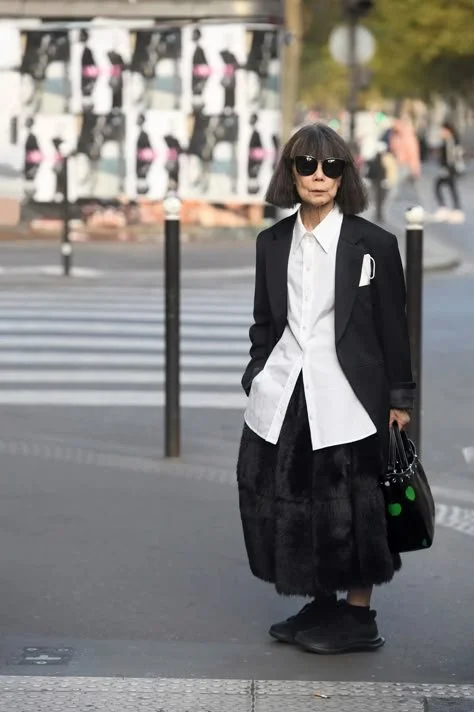Rei Kawakubo — The Disruptor
Fashion’s Real Architects: Chapter 3
She didn’t just bend fashion. She burned the blueprint.
Rei Kawakubo never wanted to make pretty clothes. And thank god for that—because if she did, the entire fashion universe might still be stuck in a loop of corseted silhouettes and glossy ad campaigns. Instead, she gave us something else entirely: confusion, distortion, silence, rebellion. She gave us Comme des Garçons.
But let’s rewind.
Born in postwar Tokyo in 1942, Rei didn’t grow up sketching ball gowns or dreaming of Paris. She studied aesthetics—philosophy, art, the theory of beauty—at Keio University. That’s important. Because Rei’s clothes have always been less about looking good and more about asking: What even is beauty? Who gets to decide? What happens when we throw all of it away?
No fashion school. No sewing background. No runway fantasies.
Just a brain wired differently.
By the late '60s, Rei was freelancing, styling, slowly creeping into design. In 1969, she started her label.
Comme des Garçons.
“Like the boys.”
It wasn’t androgyny yet—but that seed was already there.
She didn’t want to dress for the male gaze. She didn’t want to lean into “femininity.” She wanted to escape it. The whole thing. The rules. The silhouettes. The gendered expectations. From day one, Rei was rejecting what fashion told her was right.
When Paris Got Shook
Enter 1981: Rei Kawakubo and Yohji Yamamoto storm Paris with collections that didn’t whisper anti-fashion—they screamed it. Black on black. Frayed. Torn. Asymmetrical. Models with ghostly faces and no curves in sight.
Critics were horrified.
One called it “Hiroshima chic.” Others dismissed it as depressing, apocalyptic, unwearable.
But Rei? She wasn’t here for approval.
Her goal wasn’t to flatter the body. It was to reject it altogether. To reshape it, erase it, rebuild it. “The body” as we knew it in fashion—the hourglass, the legs, the bust—was irrelevant. What mattered was form, energy, distortion.Fashion became architecture. Concept. Sculpture.
The Comme Universe: A Cultural Phenomenon
What Rei built isn’t just a brand. It’s a movement with its own gravity.
CDG is a quiet powerhouse with loud ripples. It’s:
Comme des Garçons Homme – subversive menswear
CDG Shirt – classic, twisted
CDG Play – the heart logo you’ve definitely seen (yes, it’s Rei-approved)
Junya Watanabe, Noir Kei Ninomiya, Tao Kurihara – her disciples turned legends
CDG perfumes – industrial, conceptual, sometimes unsettling
Collabs with Nike, Converse, Supreme – Rei didn’t “sell out,” she warped the mainstream
And then there’s Dover Street Market.
Launched in 2004, DSM is not a store. It’s a curated shrine.
Imagine a brutalist temple, gallery, and cultural vortex all at once. Rei uses DSM to showcase the most avant designers, emerging artists, and unexpected collaborations—she's not just curating fashion, she’s curating culture.
The Woman Behind the Noise
Rei rarely speaks.
She avoids interviews. She doesn't explain her collections. She doesn’t play into the performance of fame. Her design process? Intuitive. Collaborative. Often wordless. Her team builds prototypes, and she edits, rejects, adjusts. It’s sculptural. Emotional. Brutally instinctual.
Her silence makes her louder.
You don’t watch a Rei show for the clothes—you watch it for the disturbance it creates inside you. The confusion. The discomfort. The surrender.
She once said:
“For something to be beautiful, it doesn’t have to be pretty.”
She meant that.
The Legacy. The Blueprint. The Ripple Effect.
You don’t get Demna without Rei.
You don’t get Rick Owens without Rei.
You don’t get Margiela’s deconstruction, Vetements’ distortion, The Row’s minimalism, or even Y/Project’s chaos without Rei.
She gave birth to a fashion language that had nothing to do with prettiness and everything to do with provocation.
In 2017, the Met Gala built its entire theme around her:
Rei Kawakubo / Comme des Garçons: Art of the In-Between
She became the only living designer besides Yves Saint Laurent to be honored with a solo exhibit at The Met.
That’s not fashion history. That’s global cultural history.
No Investors. No Explanations. No Compromise.
She’s still running CDG. Still designing. Still saying no to outside funding. Still shaping the future through silence, sculpture, and thought. At 80+, she’s still the most radical name in the room.
No logo hype. No influencer gimmicks. No TikTok tutorials. Just Rei—and a brand so conceptually strong it can carry multiple sub-labels, department stores, and global cult status… without ever needing to trend.
Rei Was Never Here to Fit In
She made fashion weird. Then she made it deep. Then she made it art.
And in a world where women designers still don’t get the same platform, same legacy reverence, same space to be weird without explanation—Rei is a north star. A blueprint for what happens when you stop trying to please and start trying to say something real.
This wasn’t a rebellion.
It was a reconstruction.
She didn’t want to make clothes.
She wanted to make something that didn’t exist.



